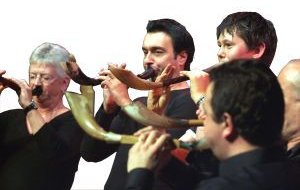
THE PIBGORN
In the Museum of Welsh Life, Sain Ffagan, there are three examples of Welsh pibggyrn, each one dating from the 18th century. But the instrument goes back much further than that.
The pibgorn is a wind instrument: a kind of primitive clarinet with a sound not unlike the Breton bombarde. If the pibgorn is taken apart, it will have four separate parts – the wooden pipe with six holes in the front and one in the back, the reed that fits onto one end of the pipe, and the two horns (cow horns) that fit onto each end. The instrument has a range of an octave.
In all probability the pibgorn was primarily an open air instrument. According to Robert Griffiths, author of Llyfr Cerdd Dannau, another common name for it was pib y bugail, and it seems that it was popular amongst farmworkers in particular.
Clwydfardd (David Griffith) states that his father had told him "that playing the Pibgorn was a common thing in those days (the end of the 18th century) in the South and that farmers' servant men were in the habit of carrying them with them when driving cattle to the fairs." But it is fair to assume that the pibgorn was used also for dancing – fast tunes can be played on it and its piercing sound is an obvious advantage in the open air.
We know that the instrument was especially popular in Anglesey. In a letter to his brother in 1759, William Morris, one of the Morysiaid Môn, states:
How pleasing it was to see the young farmworkers with their pibau cyrn (horn pipes) under their arms....gathering the cows and whistling 'Mwynen Mai' and 'Meillionnen'.
This was in the Dulas district, and he goes on to say that Meillionnen was one of the farmworkers' favourite tunes. According to the antiquarian Daines Barrington in 1770, Anglesey was the only place where the instrument was played by that time. Edward Jones, Bardd y Brenin, also confirms this in 1794 (incidentally, he had another name for the instument, cornicyll).
According to Barrington, a landowner called Mr Wynn of Penhesgedd, Anglesey, offered an annual prize to the best performer. It is said that one such competition in the 18th century attracted 200 players! There is also a description by Siôn Wiliam Prichard (1749-1829) of Christmas celebrations on the Castellior farm (between Menai Bridge and Pentraeth) where the pibgorn and other instruments were played.
It seems that the Welsh gypsies were the last people to play the pibgorn in Wales. In her book Cwpwrdd Nansi, Nansi Richards describes a neithior (a wedding party) in Llanyblodwel in the Tanat Valley where the gypsies played pibgyrn, around the mid 19th century. Her grandfather, Edward Richards, was present on that tragic night. He had retired to the loft to sleep after many hours of merriment, but in the small hours he was woken up by the sound of the pibgorn in the kitchen below. He got up from bed and started dancing, but he fell downstairs and died as a result.
As with all the other instruments, a renewed effort was made at the end of the twentieth century to give the pibgorn a new lease of life. Two or three instrument makers have a permanent waiting list and as a result the number of players is constantly increasing.
People who play the pibgorn say that the fingering is fairly straightforward to anyone who's familiar with a whistle or even a recorder, but that the main problem is that the instrument is slightly tempramental. It needs to be 'warmed up' in advance to be in tune, especially if it is to appear alongside other instruments. The pibgorn is especially effective in sessions and bands to 'raise' the performance and to give the tunes an added impetus.
GALERI CONCERT | LINKS | FORTHCOMING EVENTS | NEWS | MEMBERSHIP AND REGISTRATION
